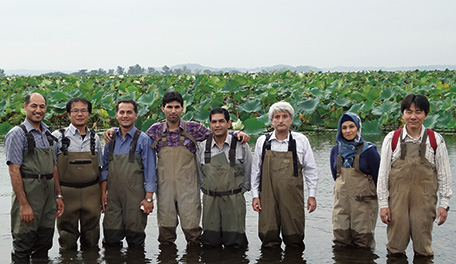Japan's Official Development Assistance White Paper 2012
Stories from the field 11
Understanding of Culture and Lifestyles Will Save Endangered Wetlands
– Ecological Management of Anzali Wetland in Iran –

Training on guidelines for capturing non-native fish species at Izunuma in Miyagi Pref. Mr. Tanimoto is at the far right. (Photo: Shinichiro Tanimoto)
Anzali Wetland sits in the northern part of Iran and faces the southern parts of the Caspian Sea. Its total area is 193 km2, and it is listed in the Ramsar Convention on Wetlands, an international treaty for the preservation of wetlands, as a landing zone for migrating birds.
The population of Iran has continued to grow in recent years; the figure for the city of Rasht, which is upstream of Anzali Wetland, has swollen to 900,000, which is three times its size 20 years ago. The wetland environment is degrading rapidly due to inflow of wastewater from homes and factories, and sediment carried in from mountainous regions. There are laws to control runoff, but they are not fully enforced. Anzali Wetland has been added to the Montreux Record, a list of Ramsar Convention wetlands in urgent need of preservation.
"The nitrogen and phosphorous levels in the waters of Anzali Wetland are two to three times above Japanese standards," said Shinichiro Tanimoto, who oversees the JICA project under which the wetland environment is managed. "It appears to be brimming with nature, but this is an effect of the wetland purifying itself. It cannot be restored if the contamination progresses past a certain level. It is an unpredictable situation." In response to the request of the government of Iran, JICA began surveying Anzali Wetland in 2003. It established a master plan for preservation and launched the Anzali Wetland Ecological Management Project, a technical cooperation, in November 2007. However, the project was suspended one year later. Mr. Tanimoto was charged with managing the project on-site when it resumed in April 2011.

An ecotour of Anzali Wetland. Many tourists come to see the blooming of lotus flowers, which are a religious symbol. (Photo: Shinichiro Tanimoto)
Mr. Tanimoto is an ecology expert who started working at Nippon Koei Co., Ltd., a consulting firm that works on aid planning for developing countries, in 2001. He has been involved with his company's surveying from the Anzali Wetland Project since it began in 2003. "It was difficult to understand Iranian people and build good relationships with the workers at the Gilan Province office of the Iranian Department of Environment, Nippon Koei's partner in this project," he said. "Iranian people have a lot of pride in their history and culture. The flip side is that they are conservative and insular, and the Gilan Province director-general and other workers had little sense of impending crisis as to the decline of the wetland environment. The challenge was to figure out how to alter our partners' awareness."
A wetland management committee that cut across the relevant authorities of government organizations was absolutely vital to the execution of this project, but the vertically structured administrative system made forming one difficult. To overcome the difficulty, the Japanese Ambassador directly requested cooperation from the governor of Gilan Province, who had greater authority than the director-general. The governor took charge and established the committee at the request of the Ambassador and commanded relevant authorities to cooperate with the committee. This is how the project got off the ground.
Ecological monitoring, socioeconomic surveying, the launch of an ecological education center and ecotourism were carried out within the framework for preservation established for the project. The work became more specific, and local workers' awareness grew little by little. Mr. Tanimoto believes that a training program in Japan was a perfect opportunity to raise workers' awareness: "They visited the Kushiro Wetland and other places as part of the training and observed and learned about wetland management. Actually seeing it with their eyes allowed them to feel the effectiveness of Japanese technology and deepened their understanding of the need for preservation and the work involved with it. They also formed a deeper bond with Japan as a result of their experience with the warm hospitality of Japanese people, which gave them a more enthusiastic attitude toward the project."
Much of the assistance related to wetland preservation is technical, but another important part of assistance is to build a relationship of trust between Japanese and Iranian people through their understanding each other's culture and way of thinking. Mutual understanding is also an issue among Iranians concerned with Anzali Wetland. For example, some people earn a living from hunting and fishing in the wetland. Those people are allotted a special area for hunting and fishing, and the socioeconomic survey performed under the project showed that they had already been working to preserve nature for quite a long time. However, aside from those who make their living in the wetland, most people living in the basin dump wastewater into the river because they are unaware of the situation and indifferent toward wetland preservation.
"There are limits to one-sided Japanese assistance," Mr. Tanimoto said. "Bringing out the possibilities that people already have is what leads to problem resolution. That is why I want to see the local people who are involved create more relationships, understand each other and work together."
